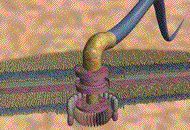
 |
In his 1997 lecture, Dr. Michael J. Behe addressed an audience at Princeton University on the subject of "Irreducible Complexity", a lecture based on his 1997 book, Darwin's Black Box. Behe incorporated a series of illustrations and graphics to demonstrate his argument for Irreducible Complexity. Below are summaries and context of those examples using graphics from the ARN lecture video. |
Darwin's "Organs of Extreme Perfection and Complexity" |
|
 Figure 1a. |
According to Michael Behe, Darwin perceived that "some simple organisms have simple light-sensitive structures." Figure 1a illustrates a simple structure of light-sensitive cells surrounded by pigment cells. In this structure, light coming from any direction sets off the light-sensitive cells; this "eye" can sense light and dark, but not direction. |
|
In Figure 1b, the simple light-sensitive spot is put into a cup. Light coming from one direction casts a shadow on the cup, giving a sense of direction. In Figure 1c, the cup is further deepened and filled with a gelatinous material to form the beginnings of a lens. Using this progression, Darwin argued an evolutionary pathway might exist from the light-sensitive structure in Figure 1 to the complicated eye of vertebrates. In his lecture, Michael Behe asks, "But where did the light sensitive spot come from?" and answers, " Darwin didn't know." Darwin declined to address the question, and correctly so, according to Behe, since 19th century science lacked the tools to investigate such a question. In the Origin of Species, Darwin dismissed the question by stating:
Furthermore, 19th century science assumed such "black boxes" to be simple in nature, and it would be only a matter of time before science would discover that. As Behe points out in the next example, this assumption of simplicity was quite wrong. |
|
The Chemistry of Vision:
|
|
| Science's misconception that the "black box" of light sensitivity would be simply explained is demonstrated by Michael Behe through a series of animations and illustrations diagraming the complicated chemical processes involved with sight. | |
 Figure 2a (359 kb) |
Figure 2a is an animation showing the first event in the pathway to vision. When the light photon first hits the retina, it interacts with the molecule "11-cis-retinal". As the photon is absorbed, the 11-cis-retinal molecule goes from an elbow-type position to a straight position. |
|
Figures 2b and 2c illustrate much of the rest of the pathway. In a complicated series of reactions, 11-cis-retinal is bound to the protein "rhodopsin" (RH). The change in the shape of the retinal forces changes in the shape of the rhodopsin (RH). This provides the rhodopsin with the ability to interact with the protein "transducin" (T). This interaction creates a situation in which a small organic molecule "GDP" falls off the transducin and is replaced by another molecule "GTP." The complex of T and GTP has the ability to interact with "phosphodiesterase", whose shape is changed by the interaction, causing a "cutting" of the molecule "cyclicGMP (cGMP), turning cGMP into 5-prime-GMP (5'-GMP). Some of the cGMP interacts with a protein "ion channel" to allow sodium ions from the outside into the inside of the cell. The ion channel closes down, the sodium concentration changes, and this changes the voltage across the membrane, causing a current to be sent down the optical nerve to the brain to be interpreted. In short, this is a much-oversimplified explanation of the "simple light-sensitive spot" of Darwin. |
|
The Cilium and the Bacterial Flagellum |
|
|
To further illustrate and demonstrate the existence of irreducibly complex systems, Michael Behe introduces his audience to the "cilium", fiber-like growths in the lungs which expel dirt and other unwelcome particles, and the "bacterial flagellum", an "outboard motor bacteria use to swim through solution." Figure 3a is a cross-sectional diagram of the cilium and its parts. Figure 3b presents an animation of the mechanism of ciliary motion. Figure 3c is an animation of the bacterial flagellum in action. Behe points out that over 50 different, separate protein parts are required in the building and operation of the flagellum. According to Behe, "these [mechanisms] are strong challenges to Darwinian gradualism." and are "a big challenge for Darwinian evolution." (A more in-depth explanation of the cilium and flagellum are presented on the previous page in the Molecular Machines area of this site.) |
|
Stanley Miller and the Origin of Life |
|
|
To illustrate science's inability in the laboratory to make progress in the discovery of how life originated, Michael Behe explains the experiments of Stanley Miller in the early 1950's. Using the apparatus shown in Figure 4a and 4b, Stanley Miller attempted to create a system which would be conducive to the formation of amino acids. He placed a variety of gases in the system and applied a spark to it. After about a week, he analyzed the chemicals that were produced. Roughly 98% consisted of "gunk", however 2% consisted of amino acids. This discovery greatly excited the scientific community, and everyone thought further experiments would demonstrate how life could form naturally, including any intermediate stages. However, those expectations have not been fulfilled in any meaningful way. Stanley Miller wrote only a few years ago in Major Events in the History of Life:
According to Behe in his lecture:
|
Copyright © 1998 Access Research Network.
All rights reserved. International copyright secured.
File Date: 6.16.98